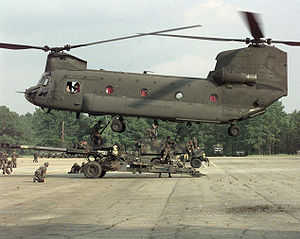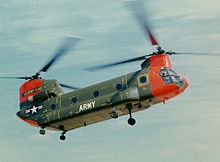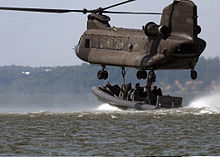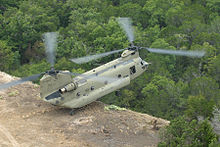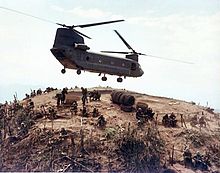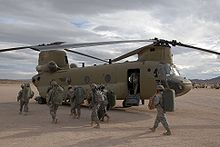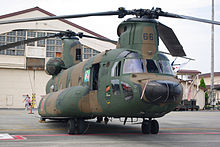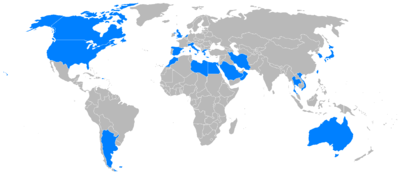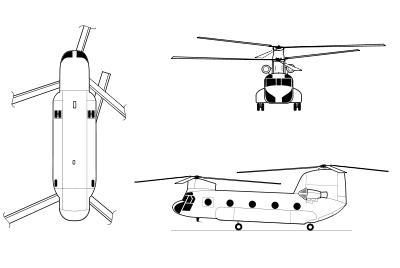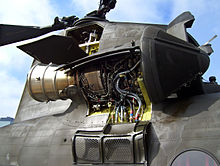- Boeing CH-47 Chinook
-
CH-47 Chinook Field artillery section sling loading an M198 howitzer for airlift by a CH-47 Chinook Role Transport helicopter National origin United States Manufacturer Boeing Rotorcraft Systems
(Ridley Park, PA plant)First flight 21 September 1961 Introduction 1962 Status Active service, in production Primary users United States Army
Japan Ground Self-Defense Force
Royal Netherlands Air Force
See CH-47 operators for othersProduced 1962 – present Number built over 1,179[1] Unit cost $35 million (2008) average[2] Developed from Vertol Model 107 Variants Boeing Chinook (UK variants) The Boeing CH-47 Chinook is an American twin-engine, tandem rotor heavy-lift helicopter. Its top speed of 170 knots (196 mph, 315 km/h) is faster than contemporary utility and attack helicopters of the 1960s. It is one of the few aircraft of that era, such as the C-130 Hercules and the UH-1 Iroquois, that is still in production and front line service with over 1,179 built to date. Its primary roles include troop movement, artillery emplacement and battlefield resupply. It has a wide loading ramp at the rear of the fuselage and three external-cargo hooks.
The Chinook was designed and initially produced by Boeing Vertol in the early 1960s. The helicopter is now produced by Boeing Rotorcraft Systems. Chinooks have been sold to 16 nations with the US Army and the Royal Air Force (see Boeing Chinook (UK variants)) being the largest users. The CH-47 is among the heaviest lifting Western helicopters.
Contents
Design and development
Early development
In late 1956, the United States Department of the Army announced plans to replace the CH-37 Mojave, which was powered by piston engines, with a new, turbine-powered helicopter.[3] Turbine engines were also a key design feature of the smaller UH-1 "Huey" utility helicopter. Following a design competition, in September 1958, a joint Army-Air Force source selection board recommended that the Army procure the Vertol medium transport helicopter. However, funding for full-scale development was not then available, and the Army vacillated on its design requirements. Some in the Army aviation corps thought that the new helicopter should be a light tactical transport aimed at taking over the missions of the old piston-engined H-21 and H-34 helicopters, and consequently capable of carrying about fifteen troops (one squad). Another faction in the Army aviation corps thought that the new helicopter should be much larger to be able to airlift a large artillery piece, and have enough internal space to carry the new MGM-31 "Pershing" Missile System.[3]
Vertol began work on a new tandem-rotor helicopter designated Vertol Model 107 or V-107 in 1957.[4][5] In June 1958, the US Army awarded a contract to Vertol for the aircraft under the YHC-1A designation.[6] The YHC-1A had a capacity for 20 troops.[3] Three were tested by the Army to derive engineering and operational data. However, the YHC-1A was considered by most of the Army users to be too heavy for the assault role and too light for the transport role.[3] The decision was made to procure a heavier transport helicopter and at the same time upgrade the UH-1 "Huey" as a tactical troop transport. The YHC-1A would be improved and adopted by the Marines as the CH-46 Sea Knight in 1962.[7] The Army then ordered the larger Model 114 under the designation HC-1B.[8] The pre-production Boeing Vertol YCH-1B made its initial hovering flight on 21 September 1961. In 1962 the HC-1B was redesignated the CH-47A under the 1962 United States Tri-Service aircraft designation system.
The name "Chinook" alludes to the Chinook people of the Pacific Northwest. The CH-47 is powered by two turboshaft engines, mounted on each side of the helicopter's rear end and connected to the rotors by driveshafts. Initial models were fitted with engines of 2,200 horsepower. The counter-rotating rotors eliminate the need for an anti-torque vertical rotor, allowing all power to be used for lift and thrust. The ability to adjust lift in either rotor makes it less sensitive to changes in the center of gravity, important for the cargo lifting role. If one engine fails, the other can drive both rotors.[9] The "sizing" of the Chinook was directly related to the growth of the Huey and the Army's tacticians' insistence that initial air assaults be built around the squad. The Army pushed for both the Huey and the Chinook, and this focus was responsible for the acceleration of its air mobility effort.[3]
Improved and later versions
Improved and more powerful versions of the CH-47 have been developed since the helicopter entered service. The US Army's first major design leap was the now-common CH-47D, which entered service in 1982. Improvements from the CH-47C included upgraded engines, composite rotor blades, a redesigned cockpit to reduce pilot workload, improved and redundant electrical systems, an advanced flight control system and improved avionics.[10] The latest mainstream generation is the CH-47F, which features several major upgrades to reduce maintenance, digitized flight controls, and is powered by two 4,733-horsepower Honeywell engines.[11]
A commercial model of the Chinook, the Boeing-Vertol Model 234, is used worldwide for logging, construction, fighting forest fires, and supporting petroleum extraction operations. On 15 December 2006, the Columbia Helicopters company of the Salem, Oregon, metropolitan area, purchased the Type Certificate of the Model 234 from Boeing.[12] The Chinook has also been licensed to be built by companies outside of the United States, such as Elicotteri Meridionali (now AgustaWestland) in Italy, Kawasaki in Japan, and a company in the United Kingdom.[who?]
Operational history
Vietnam War
The Army finally settled on the larger Chinook as its standard medium transport helicopter and as of February 1966, 161 aircraft had been delivered to the Army. The 1st Cavalry Division had brought their organic Chinook battalion with them when they arrived in 1965 and a separate aviation medium helicopter company, the 147th, had arrived in Vietnam on 29 November 1965.[13] This latter company was initially placed in direct support of the 1st Infantry Division.
The most spectacular mission in Vietnam for the Chinook was the placing of artillery batteries in perilous mountain positions inaccessible by any other means, and then keeping them resupplied with large quantities of ammunition.[3] The 1st Cavalry Division found that its Chinooks were limited to 7,000 pounds payload when operating in the mountains, but could carry an additional 1,000 pounds when operating near the coast.[3] The early Chinook design was limited by its rotor system which did not permit full use of the installed power, and users were anxious for an improved version which would upgrade this system.
As with any new piece of equipment, the Chinook presented a major problem of "customer education". Commanders and crew chiefs had to be constantly alert that eager soldiers did not overload the temptingly large cargo compartment. It would be some time before troops would be experts at using sling loads.[3] The Chinook soon proved to be such an invaluable aircraft for artillery movement and heavy logistics that it was seldom used as an assault troop carrier. Some of the Chinook fleet were used for casualty evacuation, due to the very heavy demand for the helicopters they were usually overburdened with wounded.[14] Perhaps the most cost effective use of the Chinook was the recovery of other downed aircraft.[15]
The Chinooks were generally armed with a single 7.62 millimeter M60 machine gun on a pintle mount on either side of the machine for self-defense, with stops fitted to keep the gunners from firing into the rotor blades. Dust filters were also added to improve engine reliability. At its peak employment in Vietnam, there were 22 Chinook units in operation.
Of the nearly 750 Chinooks in the US and Republic of Vietnam fleets, about 200 were lost in combat or wartime operational accidents.[16] US Army supplied Chinooks to the Australian Task Force as required.
Iran-Iraq war
During the 1970s, the United States and Iran had a strong relationship, in which the Iranian armed forces began to use many American military aircraft, most notably the F-14 Tomcat, as part of a modernisation programme.[17] After an agreement signed between Boeing and Elicotteri Meridionali, the Imperial Iranian Air Force purchased 20 Elicotteri Meridionali-built CH-47Cs in 1971.[18] The Imperial Iranian Army Aviation purchased 70 CH-47Cs from Elicotteri Meridionali during the period of 1972–1976. In late 1978, Iran placed an order for an additional 50 helicopters with Elicotteri Meridionali, but that order was canceled immediately after the revolution.[19] Despite the arms embargo on place upon Iran,[20][21] they have managed to keep their fleet operational.[22][23]
In the 1978 Iranian Chinook shootdown, four Iranian CH-47C Chinooks penetrated 15–20 km into Soviet airspace in the Turkimenistan Military District. They were intercepted by a MiG-23M which shot down one Chinook, killing eight crew members, and forced a second one to land. Chinooks were used in efforts by the Imperial Iranian loyalist forces to resist the 1979 Iranian revolution.[24] During the war with Iraq, Iran made heavy use of its US-bought equipment, and lost at least 8 Chinooks during the 1980–1988 period; most notably during a clash on 15 July 1983, where an Iraqi Mirage F-1 destroyed three Iranian CH-47s transporting troops to the front line.
Falklands War
The Chinook was used both by Argentina and the United Kingdom during the Falklands War in 1982.[25] The Argentine Air Force and the Argentine Army deployed four CH-47C (two each) which were widely used in general transport duties. Of the Army's airframes one was destroyed on the ground by a Harrier while the other was captured (and reused after the war) by the British.[26] Both Air Force helicopters returned to Argentina and remained in service until 2002.[27]
Iraq and Afghanistan
 Soldiers wait for pickup from two Chinooks in Afghanistan, 2008.
Soldiers wait for pickup from two Chinooks in Afghanistan, 2008.
Approximately 163 CH-47Ds served in Kuwait and Iraq during Operations Desert Shield and Desert Storm in 1990–91.[28]
The CH-47D has seen wide use in Operation Enduring Freedom in Afghanistan and Operation Iraqi Freedom in Iraq. The Chinook is being used in air assault missions, inserting troops into fire bases and later bringing food, water, and ammunition. It is also the casualty evacuation (casevac) aircraft of choice in the British Army.[29] In today's usage it is typically escorted by attack helicopters such as the AH-64 Apache for protection.[30][31] Its tandem rotor design and lift capacity have been found to be particularly useful in the mountainous terrain of Afghanistan where high altitudes and temperatures limit the use of the UH-60 Black Hawk.[2] The CH-47F is being fielded by more units such as the 101st Combat Aviation Brigade and 4th Combat Aviation Brigade in the U.S. Army as it continues to operate in Afghanistan.[citation needed]
The Chinooks of several nations have participated in the Afghanistan War, including aircraft from Britain, Italy, the Netherlands, Spain, Canada, and Australia. Despite the age of the Chinook, it is still in heavy demand, in part due its proven versatility and ability to operate in demanding environments such as Afghanistan.[32][33]
On 6 August 2011, a Chinook crashed near Kabul killing all of the 38 aboard. It was reportedly shot down with a rocket-propelled grenade by the Taliban. The 38 were NATO forces including about 30 U.S. special forces and seven Afghan troops. The previous biggest single-day loss for Americans also involved a Chinook that was shot down near Kabul in Kunar Province in June 2005 and killed all aboard, including a 16-member U.S. Special Operations team.[34][35]
Japan
Three CH-47 Chinooks were used to cool Reactors 3 and 4 of the Fukushima Nuclear power-plant with sea water after the 9.0 earthquake in 2011.[36][37] To protect the crew from the heightened radiation levels, lead plates were attached to the floor.[38][39]
Variants
HC-1B
The pre-1962 designation for Model 114 development aircraft that would be re-designated CH-47 Chinook.
CH-47A
The all-weather, medium-lift CH-47A Chinook was powered initially by Lycoming T55-L-5 engines rated at 2,200 horsepower (1,640 kW) but then replaced by the T55-L-7 rated at 2,650 hp (1,980 kW) engines or T55-L-7C engines rated at 2,850 hp (2,130 kW). The CH-47A had a maximum gross weight of 33,000 pounds (15,000 kg). Initial delivery of the CH-47A Chinook to the US Army was in August 1962. A total of 349 were built.
ACH-47A
The ACH-47A was originally known as the Armed/Armored CH-47A (or A/ACH-47A). It was officially designated ACH-47A by US Army Attack Cargo Helicopter and unofficially Guns A Go-Go. Four CH-47A helicopters were converted to gunships by Boeing Vertol in late 1965. Three were assigned to the 53rd Aviation Detachment in South Vietnam for testing, with the remaining one retained in the US for weapons testing. By 1966, the 53rd was redesignated the 1st Aviation Detachment (Provisional) and attached to the 228th Assault Support Helicopter Battalion of the 1st Cavalry Division (Airmobile). By 1968, only one gunship remained, and logistical concerns prevented more conversions. It was returned to the United States, and the program stopped.
The ACH-47A carried five M60D 7.62x51 mm machine guns or M2HB .50 caliber machine guns, provided by the XM32 and XM33 armament subsystems, two M24A1 20 mm cannons, two XM159B/XM159C 19-Tube 2.75 in rocket launchers or sometimes two M18/M18A1 7.62×51 mm gun pods, and a single M75 40 mm grenade launcher in the XM5/M5 armament subsystem (more commonly seen on the UH-1 series of helicopters). The surviving aircraft, Easy Money, has been restored and is on display at Redstone Arsenal, Alabama.[40]
CH-47B
The CH-47B was an interim solution while Boeing worked on a more substantially improved CH-47C. CH-47B was powered by two Lycoming T55-L-7C 2,850 shp (2,130 kW) engines. It featured a blunted rear rotor pylon, redesigned asymmetrical rotor blades, and strakes along the rear ramp and fuselage to improve flying characteristics. It could be equipped with two door-mounted M60D 7.62 mm NATO machine guns on the M24 armament subsystem and a ramp-mounted M60D using the M41 armament subsystem. Some CH-47 "bombers" were equipped to drop tear gas or napalm from the rear cargo ramp onto NLF (aka Việt Cộng) bunkers. The CH-47 could be equipped with a hoist and cargo hook. The Chinook proved especially valuable in "Pipe Smoke" aircraft recovery missions. The "Hook" recovered about 12,000 aircraft valued at over $3.6 billion during the war. 108 built.
CH-47C
The CH-47C featured more powerful engines and transmissions.[41] Three versions of the "C model" were built. The first had Lycoming T55-L-7C engines delivering 2,850 shp (2,130 kW). The "Super C" included Lycoming T55-L-11 engines delivering 3,750 shp (2,800 kW), an upgraded maximum gross weight of 46,000 lb (21,000 kg) and a pitch stability augmentation system (PSAS). Due to difficulties with the T55-L-11 engines, which were hurriedly brought to war to increase payload, they were temporarily removed from the "Super C" prior to 1970 and the very reliable Lycoming T55-L-7C's were installed until the L-11 engine difficulties could be quantified and corrected. This L-7C engine configuration was affectionately referred to as the "baby C" although it was still a Super C. It distinguished itself from the "C" in that it had PSAS and an uprated maximum gross weight. The CH-47 A, B, and all variants of the C were not able to receive certification from the FAA for civil use due to the non-redundant hydraulic flight boost system drive. A redesign of the hydraulic boost system drive was incorporated in the CH-47D which allowed that model to achieve FAA certification as the Boeing Model 234. 233 CH-47Cs were built.
The CH-47A, B, and all versions of the C saw wide use during the Vietnam war. They replaced the H-21 Shawnee in the combat assault support role.
CH-47D
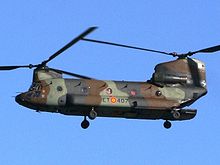 CH-47D of the Spanish Army in 2009
CH-47D of the Spanish Army in 2009
The CH-47D model was originally powered by two T55-L-712 engines, but most are now fitted with the T55-GA-714A. Models CH-47A, CH-47B, and CH-47C, all used the same airframe, but later models featured upgraded engines. With its triple-hook cargo system, the CH-47D can carry heavy payloads internally and up to 26,000 pounds (for example, bulldozers and 40-foot / 12 m containers) externally, at speeds over 155 mph (250 km/h). The aircraft's top cruising speed is 163 mph (142 knots). The D-model was first introduced into service in 1979. In air assault operations, it often serves as the principal mover of the 155 mm M198 howitzer, 30 rounds of ammunition, and an 11-man crew. Like most US Army helicopters, the Chinook has advanced avionics and electronics, including the Global Positioning System.
Nearly all of the Army production CH-47D models were conversions from previous US Army A, B, and C models with a total of 472 converted into D-models. The last US Army D-model built was delivered to the US Army Reserve, located at Fort Hood, Texas, in early 2002.[42]
In 2008, Canada purchased 6 CH-47Ds for use with the Canadian Helicopter Force Afghanistan from the United States for $252 million.[43] The helicopters were transferred to the Canadian Forces on 30 December 2008.[44]
MH-47D
 A US MH-47D stands ready to receive medical supplies in Feyzabad, Afghanistan.
A US MH-47D stands ready to receive medical supplies in Feyzabad, Afghanistan.
The MH-47D variant was developed for special forces operations and has in-flight refueling capability, a fast-rope rappelling system and other upgrades. The MH-47D was used by US Army 160th Special Operations Aviation Regiment. 12 MH-47D helicopters were produced. 6 were conversions from CH-47A models and 6 were conversions from CH-47C models.[45]
MH-47E
The current model used by US Army Special Operations is the MH-47E. Beginning with the E model prototype manufactured in 1991, there were a total of 26 Special Operations Aircraft produced. All aircraft were assigned to 2–160th SOAR(A) "Nightstalkers", home based at Fort Campbell Kentucky. E models were conversions from existing CH-47C model airframes. The MH-47E has similar capabilities as the MH-47D, but includes an increased fuel capacity similar to the CH-47SD and terrain following/terrain avoidance radar.[46]
In 1995, the Royal Air Force ordered eight Chinook HC3s, effectively a low cost version of the MH-47E for the special forces operations role. They were delivered in 2001 but never entered operational service due to technical issues with their avionics fit, unique to the HC3. In 2008, work started to downgrade the HC3s to HC2 standard, to enable them to enter service.[47]
CH-47F
The CH-47F, an upgraded D model, first flew in 2001. The first production model was rolled out on 15 June 2006 at the Boeing facility in Ridley Park, Pennsylvania, and had its maiden flight on October 23, 2006.[48] The CH-47F was designed to extend the service life of the Chinook class beyond 2030. Among its upgrades are new 4,868 shaft horsepower Honeywell engines, improved avionics, and an upgraded airframe with larger single-piece sections to reduce part count and need for fasteners.[49] The new milled construction will reduce vibrations, eliminate points of joint flexing, and reduce the need for inspections and repairs, and reduce maintenance costs. It is also expected to increase service life.[50] The CH-47F can fly at speeds of over 175 mph (282 km/h) with a payload of more than 21,000 lb (9,530 kg).[51] The improved avionics include a Rockwell Collins Common Avionics Architecture System (CAAS) cockpit, and BAE Systems' Digital Advanced Flight Control System (DAFCS).[49]
Boeing has delivered 48 F-model helicopters to the United States Army; on 26 August 2008, Boeing announced that the Army has signed a five-year contract, worth over $4.8 billion for 191 more, plus 24 options.[51] In February 2007, the Netherlands were the first international customer to order the F model; six helicopters were ordered to expand their current fleet to 17. These helicopters will be equipped with an upgraded version of the Honeywell Avionics Control Management System (ACMS) cockpit.[52] The Netherlands also plans to upgrade its current 11 CH-47Ds to the CH-47F configuration.[53] On 10 August 2009, Canada signed a contract to purchase 15 CH-47Fs for delivery in 2013–14,[54] entering service with the Royal Canadian Air Force after its planned withdrawal from combat operations in Afghanistan.[55] They will be based at CFB Petawawa.
On 15 December 2009, the British government announced its Future Helicopter Strategy including the purchase of 24 new CH-47F Chinooks to be delivered from 2012.[56] Australia ordered seven CH-47Fs in March 2010. These aircraft are to replace the Australian Army's six CH-47Ds between 2014 and 2017.[57][58]
MH-47G
 MH-47G Chinook, during the aircraft's rollout ceremony 6 May 2007 at Boeing
MH-47G Chinook, during the aircraft's rollout ceremony 6 May 2007 at Boeing
The MH-47G Special Operations Aviation (SOA) version is currently being delivered to the US Army. It is similar to the MH-47E, but features a more sophisticated avionics including a digital Common Avionics Architecture System (CAAS). The CAAS is common glass cockpit used by different helicopters such as MH-60K/Ls, CH-53E/Ks, and ARH-70As.[59] The MH-47G will also incorporate all of the new sections of the CH-47F.[60]
Based on operational experience in Afghanistan, the CH-47 was found to be an effective substitute for the UH-60 Black Hawk as an assault helicopter. With its larger payload, range, and higher operating speed, one Chinook can replace up to five UH-60s in this role as an air assault transport.[61]
The new modernization program will improve MH-47D and MH-47E Special Operations Chinooks to the MH-47G design specs. A total of 25 MH-47E and 11 MH-47D aircraft were upgraded by the end of 2003. In 2002 the army announced plans to expand the Special Operations Aviation Regiment. The expansion would add 12 additional MH-47G helicopters.[62] On February 10, 2011, Leaders and employees from the H-47 program gathered for a ceremony at Boeing's helicopter facility in Ridley Township, PA., to commemorate the delivery of the final MH-47G Chinook to U.S. Army Special Operations Command.
CH-47J
CH-47JA of the Japan Ground Self-Defense Force, during the USAF Yokota Air Base Friendship Festival, 22 August 2009.
The CH-47J is a medium-transport helicopter for the Japan Ground Self-Defense Force (JGSDF), and the Japan Air Self-Defense Force (JASDF). The differences between the CH-47J and the CH-47D are the engine, rotor brake and avionics. To use it by the general transportation, SAR and disaster activity like U.S. forces.[63] The CH-47JA, introduced in 1993, is a long range version of the CH-47J, fitted with enlarged fuel tank, an AAQ-16 FLIR in a turret under the nose, and a partial glass cockpit.[63][64] Both versions are built under license in Japan by Kawasaki Heavy Industries, who produced 61 aircraft by April 2001.[65]
The Japan Defense Agency ordered 54 aircraft of which 39 were for the JGSDF and 15 were for the JASDF. Boeing supplied flyable aircraft, to which Kawasaki added full avionics, interior, and final paint.[66] The CH-47J model Chinook (N7425H) made its first flight in January 1986, and it was sent to Kawasaki in April.[67] Boeing began delivering five CH-47J kits in September 1985 for assembly at Kawasaki.[66]
HH-47
On 9 November 2006, the HH-47, a new variant of the Chinook based on the MH-47G, was selected by the US Air Force as the winner of the Combat Search and Rescue (CSAR-X) competition. Four development HH-47s were to be built, with the first of 141 production aircraft planned to enter service in 2012.[68][69] However, in February 2007 the contract award was protested and the GAO ordered the CSAR-X project to be re-bid.[70] In February 2010, the US Air Force announced plans to replace aging HH-60G helicopters. The Air Force is deferring secondary combat search and rescue requirements that called for a larger helicopter.[71][72]
Other export models
The Royal Air Force variant of the CH-47C is known as the Chinook HC1. The export version of the CH-47C Chinook for the Italian Army was designated "CH-47C Plus".
The HH-47D is a search and rescue version for the Republic of Korea Air Force. The CH-47DG is an upgraded version of the CH-47C for Greece.
The Royal Air Force versions of the CH-47D are known as the Chinook HC2 and HC2A. While the CH-47SD (also known as the "Super D") is a modified variant of the CH-47D, with extended range fuel tanks and higher payload carrying capacity; the CH-47SD is currently in use by the Republic of Singapore Air Force, Hellenic Army and the Republic of China Army.
Eight CH-47C Chinooks were delivered to the Canadian Forces in 1974. These Chinooks were in Canadian service until 1991, with the designation CH-147. These aircraft were subsequently sold to the Netherlands and are now operated by the Royal Netherlands Air Force as CH-47Ds. Additional orders are expected from Italy. Plans are to upgrade the current fleet of CH-47Ds to the F-model standard and eventually enlarge the fleet to 20 aircraft, pending funding.
Civilian models
- Model 234LR (long range): Commercial transport helicopter. The Model 234LR can be fitted out as an all-passenger, all-cargo, or cargo/passenger transport helicopter.
- Model 234ER (extended range): Commercial transport version.
- Model MLR (multi-purpose long range): Commercial transport version.
- Model 234UT (utility transport): Utility transport helicopter.
- Model 414: The Model 414 is the international export version of the CH-47D. It is also known as the CH-47D International Chinook.
Derivatives
In 1969, work on the experimental Model 347 was begun. It was a CH-47A with a lengthened fuselage, four-blade rotors, detachable wings mounted on top of the fuselage and other changes. It first flew on 27 May 1970 and was evaluated for a few years.[73]
In 1973, the Army contracted Boeing to design a "Heavy Lift Helicopter" (HLH), designated XCH-62A. It appeared to be a scaled-up CH-47 without a conventional body, in a configuration similar to the S-64 Skycrane (CH-54 Tarhe), but the project was canceled in 1975. The program was restarted for test flights in the 1980s and was again not funded by Congress.[73] The scaled up model of the HLH was scrapped at the end of 2005 at Fort Rucker, Alabama.[74]
Operators
Main article: List of CH-47 Chinook operatorsMilitary operators
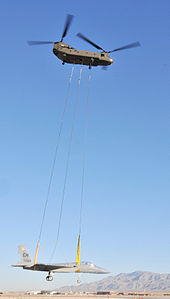 A CH-47 lifts an F-15 to a training installation at Creech Air Force Base
A CH-47 lifts an F-15 to a training installation at Creech Air Force Base
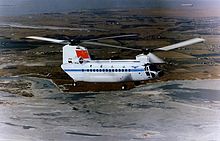 Boeing 234 flying in Civil Aviation Administration of China. Demonstration aircraft.
Boeing 234 flying in Civil Aviation Administration of China. Demonstration aircraft.
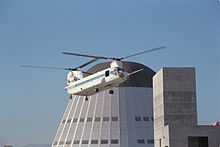 NASA CH-47B used as an in-flight simulator. Former US Army 66-19138
NASA CH-47B used as an in-flight simulator. Former US Army 66-19138
 Australia
Australia Canada[75]
Canada[75] Egypt
Egypt Greece
Greece Iran
Iran Italy
Italy Japan
Japan Libya
Libya Morocco
Morocco Netherlands
Netherlands Republic of China (Taiwan)
Republic of China (Taiwan) Saudi Arabia
Saudi Arabia Singapore
Singapore South Korea
South Korea Spain
Spain Thailand
Thailand Turkey
Turkey- ordered 6 CH-47s[76]
 United Kingdom
United Kingdom- see Boeing Chinook (UK variants)
 United Arab Emirates
United Arab Emirates United States
United States Vietnam
Vietnam- captured ex-USAF Chinook CH-47A
Civilian operators
- Helifor Canada Corp (under lease from Columbia Helicopters)
- Taiwan National Fire Administration (currently operates three 234s)
- Civil Aviation Administration of China (one month demonstration period)[77]
- Icaro Air (under lease from Columbia Helicopters)
- CHC Helikopter Service (formerly Helikopter Services)
- USA
- Columbia Helicopters (currently operates seven 234s)
- Era Aviation
- NASA (14 August 1979 – 20 September 1989)[78]
- Trump Airlines
Former civil operators are marked by italics
Notable accidents and incidents
- On 11 September 1982, at an airshow in Mannheim, Germany a United States Army Chinook (serial number 74-22292) carrying parachutists crashed, killing 46 people. The crash was later found to be caused by an accumulation of ground walnut shells that had been used to clean the machinery.[79][80][81]
- On 6 November 1986, a British International Helicopters Chinook crashed on approach to Sumburgh Airport, Shetland Islands resulting in the loss of 45 lives and the withdrawal of the Chinook from crew servicing flights in the North Sea.[82]
- Major Marie Therese Rossi Cayton was the first American woman to fly in combat during Desert Storm in 1991. She was killed when her Chinook helicopter crashed on 1 March 1991 after colliding with a microwave tower during a dust storm.[83]
- On 29 May 2001 a ROK Army CH-47D installing a sculpture onto Olympic Bridge in Seoul, South Korea failed to unlatch the sculpture. The helicopter's rotors struck the monument; then the fuselage hit and broke into two. One section crashed onto the bridge in flames and the other fell into the river. All three crew members on board died.[84]
- On 11 September 2004 a Greek Air Force CH-47SD crashed into the sea off Mount Athos. All 17 people on board were killed, including four senior figures in the Greek Orthodox Church.[85]
Specifications (CH-47D)
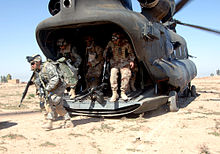 M240 machine gun emplacement on the loading ramp, as well as another partly visible on the right shoulder window
M240 machine gun emplacement on the loading ramp, as well as another partly visible on the right shoulder window
Data from Boeing CH-47D/F,[86] Army Chinook file,[87] International Directory[88]
General characteristics
- Crew: 3 (pilot, copilot, flight engineer)
- Capacity:
- 33–55 troops or
- 24 litters and 3 attendants or
- 28,000 lb (12,700 kg) cargo
- Length: 98 ft 10 in (30.1 m)
- Rotor diameter: 60 ft 0 in (18.3 m)
- Height: 18 ft 11 in (5.7 m)
- Disc area: 5,600 ft2 (2,800 ft2 per rotor disc) (260 m2)
- Empty weight: 23,400 lb (10,185 kg)
- Loaded weight: 26,680 lb (12,100 kg)
- Max takeoff weight: 50,000 lb (22,680 kg)
- Powerplant: 2 × Lycoming T55-GA-712 turboshaft, 3,750 hp (2,796 kW) each
Performance
- Maximum speed: 170 knots (196 mph, 315 km/h)
- Cruise speed: 130 kt (137 mph, 220 km/h)
- Range: 400 nmi (450 mi, 741 km)
- Ferry range: 1,216 nmi (1,400 mi, 2,252 km[89])
- Service ceiling: 18,500 ft (5,640 m)
- Rate of climb: 1,522 ft/min (10.1 m/s)
- Disc loading: 9.5 lb/ft2 (47 kg/m2)
- Power/mass: 0.28 hp/lb (460 W/kg)
Armament
- up to 3 pintle mounted medium machine guns (1 on loading ramp and 2 at shoulder windows), generally 7.62 mm (0.308 in) M240/FN MAG machine guns
Avionics
- Rockwell CAAS (MH-47G/CH-47F)
See also
- 17th Aviation Brigade (United States)
- United States Army Aviation and Missile Command
- Related development
- Aircraft of comparable role, configuration and era
- Related lists
References
- ^ CH-47D/F Chinook page, Boeing
- ^ a b "Chinook Replaces Blackhawk in Combat". Air Transportation. 5 March 2008. http://www.strategypage.com/htmw/htairmo/20080305.aspx.
- ^ a b c d e f g h Leuutenant General John J. Tolson (1989). Vietnam Studies: Airmobility 1961–71. US Government Printing Office. CMH Pub 90-4. http://www.history.army.mil/books/vietnam/airmobility/airmobility-fm.html.
- ^ Apostolo, Giorgio. The Illustrated Encyclopedia of Helicopters. New York: Bonanza Books. 1984. ISBN 9780517439357.
- ^ Goebel, Greg. Origins: Vertol V-107 & V-114. Vectorsite.net, 1 December 2009.
- ^ Spenser, Jay P. Whirlybirds, A History of the U.S. Helicopter Pioneers. University of Washington Press, 1998. ISBN 0-295-97699-3.
- ^ Holmes, Alexander (26 October 1962). "The Quiet Americans-Our Marines Overseas". Los Angeles Times. http://pqasb.pqarchiver.com/latimes/access/454317782.html?dids=454317782:454317782&FMT=ABS&FMTS=ABS:AI&type=historic&date=Oct+26%2C+1962&author=&pub=Los+Angeles+Times&desc=The+Quiet+Americans--Our+Marines+Overseas&pqatl=google.
- ^ Warwick, Graham (1 April 2008). "Chinook: Five decades of development". Flight International. http://www.flightglobal.com/articles/2008/04/01/222553/chinook-five-decades-of-development.html.
- ^ Chinook Information and diagrams about the transmission system
- ^ Belden, Tom (21 May 1982). "This Whirlybird's an early bird: Boeing Vertol's Army copter delivered on budget". Philadelphia Inquirer. http://nl.newsbank.com/nl-search/we/Archives?p_product=PI&s_site=philly&p_multi=PI&p_theme=realcities&p_action=search&p_maxdocs=200&p_topdoc=1&p_text_direct-0=0EB293DCB78A3557&p_field_direct-0=document_id&p_perpage=10&p_sort=YMD_date:D&s_trackval=GooglePM.
- ^ "Boeing Receives $1.15B Contract for 15 Canadian Chinooks, Announces Matching Reinvestment in Industry". Boeing. 10 August 2009. http://boeing.mediaroom.com/index.php?s=43&item=784.
- ^ "Type Certificate Data Sheet No. H9EA" (.pdf). Federal Aviation Administration. 17 January 2007. http://www.airweb.faa.gov/Regulatory_and_Guidance_Library%5CrgMakeModel.nsf/0/84EBE8780BF584058625726B00657D0E/$FILE/H9EA.pdf. Retrieved 8 February 2007.
- ^ "Chinook Copter to Vietnam". New York Times. 11 August 1965. http://select.nytimes.com/gst/abstract.html?res=F40D10FF3C5A157A93C3A81783D85F418685F9.
- ^ Scannell-Desch, Elizabeth A.; Marion Anderson (2000). "Hardships and Personal Strategies of Vietnam War Nurses". Western Journal of Nursing Research 22 (5): 526–550. http://wjn.sagepub.com/cgi/content/abstract/22/5/526.
- ^ Dunstan, Simon (2003). Vietnam choppers: helicopters in battle 1950–75. Osprey Publishing. p. 81. http://books.google.co.uk/books?hl=en&lr=&id=P-C6dCXJ4zgC&oi=fnd&pg=PA9&dq=Vietnam+Chinook&ots=s2elEs6cj_&sig=IhopePl5z_GtOAQMmc21R55UsTA#v=onepage&q=Chinook&f=false.
- ^ Anderton, David & Miller, Jay – Boeing Helicopters CH-47 Chinook. Arlington : Aerofax, Inc, 1989, pp 8, ISBN 0-942548-42-6
- ^ Marder, Murray (26 July 1973). "Oil pact with U.S. firm: Iran signs agreement". Victoria Advocate. http://news.google.co.uk/newspapers?id=2r4bAAAAIBAJ&sjid=WFoEAAAAIBAJ&pg=4795,3807638&dq=f14+iran&hl=en.
- ^ Szulcs, Tad (25 July 1971). "U.S., Britain Quietly Back Military Build-Up of Iran". New York Times. http://select.nytimes.com/gst/abstract.html?res=F00A13FF3455127B93C7AB178CD85F458785F9.
- ^ "US reportedly will buy copters so Iran can't". Milwaukee Journal. 22 January 1984. http://news.google.co.uk/newspapers?id=XGoaAAAAIBAJ&sjid=BCoEAAAAIBAJ&pg=7019,117947&dq=iran+chinook&hl=en.
- ^ Roy, Amit (23 February 1980). "Iran feeling squeeze of European embargo". Spokesman-Review. http://news.google.co.uk/newspapers?id=leURAAAAIBAJ&sjid=Oe4DAAAAIBAJ&pg=4515,3550419&dq=iran+chinook&hl=en.
- ^ "U.S. cuts off plane parts to Iran". Chicago Tribune. 9 November 1979. http://pqasb.pqarchiver.com/chicagotribune/access/621269432.html?dids=621269432:621269432&FMT=ABS&FMTS=ABS:AI&type=historic&date=Nov+09%2C+1979&author=&pub=Chicago+Tribune&desc=U.S.+cuts+off+plane+parts+to+Iran&pqatl=google.
- ^ "Iran, China Seek Military Equipment From Pentagon Surplus Auctions". Fox News. 16 January 2007. http://www.foxnews.com/story/0,2933,243858,00.html.
- ^ "Iranian engineers overhaul Chinook helicopter". BBC News. 27 January 2007. http://nl.newsbank.com/nl-search/we/Archives?p_product=NewsLibrary&p_multi=BBAB&d_place=BBAB&p_theme=newslibrary2&p_action=search&p_maxdocs=200&p_topdoc=1&p_text_direct-0=116F24F631F8B598&p_field_direct-0=document_id&p_perpage=10&p_sort=YMD_date:D&s_trackval=GooglePM.
- ^ "Iranian troops smash four-day siege by Kurds". Lakeland Ledger. 27 August 1979. http://news.google.co.uk/newspapers?id=zbMwAAAAIBAJ&sjid=-PoDAAAAIBAJ&pg=4025,4705243&dq=iran+orders+chinook&hl=en.
- ^ "British air and land forces outnumbered". Boston Globe. 21 May 1982. http://pqasb.pqarchiver.com/boston/access/666369341.html?dids=666369341:666369341&FMT=ABS&FMTS=ABS:FT&type=current&date=May+21%2C+1982&author=Associated+Press&pub=Boston+Globe+(pre-1997+Fulltext)&desc=BRITISH+AIR+AND+LAND+FORCES+OUTNUMBERED&pqatl=google.
- ^ "MoD uses 'cut and shut' chopper". BBC News. 18 July 2009. http://news.bbc.co.uk/2/hi/uk_news/england/devon/8157265.stm.
- ^ boeing-vertol CH-47C Chinook in Argentina – Comando de Aviación del Ejército argentino
- ^ "CH-47D/MH-47E Chinook". Army Technology. SPG Media Limited. 2006. http://www.army-technology.com/projects/chinook/. Retrieved 27 August 2006.
- ^ "Paras tell of their fear under fire". The Herald. 12 September 2000. http://pqasb.pqarchiver.com/smgpubs/access/60610400.html?dids=60610400:60610400&FMT=ABS&FMTS=ABS:FT&type=current&date=Sep+12%2C+2000&author=&pub=The+Herald&desc=Paras+tell+of+their+fear+under+fire%3B+'It+was+scary+but+once+we+got+into+the+fighting%2C+the+training+took+over'&pqatl=google.
- ^ "UK leads Nato into Kosovo". BBC News. 12 June 1999. http://news.bbc.co.uk/1/hi/uk/367078.stm.
- ^ Crerar, Pippa (26 January 2006). "Scots set for Taliban Hotspots". Daily Record. http://www.dailyrecord.co.uk/news/tm_objectid=16627753&method=full&siteid=66633&headline=scots-set-for-taliban-hotspots--name_page.html.
- ^ "Boeing Receives $1.15B Contract for 15 Canadian Chinooks, Announces Matching Reinvestment in Industry". Boeing, 10 August 2009.
- ^ "MoD to buy 22 new Chinooks". London: The Telegraph. 15 December 2009. http://www.telegraph.co.uk/news/newstopics/politics/defence/6816249/MoD-to-buy-22-new-Chinooks.html.
- ^ "Copter Downed by Taliban Fire; Elite U.S. Unit Among Dead". The New York Times, 6 August 2011.
- ^ "31 U.S. Troops Killed in Afghanistan Helo Crash". Defense News, 6 August 2011.
- ^ Japanese military helicopters dump water on Fukushima nuclear power plant
- ^ CH-47 Chinook helicopter begins dumping water on nuclear reactor
- ^ http://www.citytv.com/toronto/citynews/topic/japan-earthquake/article/119408--concern-grows-over-spent-fuel-pools-as-crews-spray-nuclear-plant-with-water Concern grows over spent fuel pools as crews spray nuclear plant with water
- ^ http://www.nzherald.co.nz/japan-tsunami/news/article.cfm?c_id=1503051&objectid=10713272 Japan crisis: Radiation levels begin to dip
- ^ Guns a Go-Go. chinook-helicopter.com
- ^ US Army CH-47A / CH-47B / CH-47C / CH-47D / SOA Chinooks. Vectorsite.net, 1 July 2004.
- ^ Boeing CH-47D model Chinook helicopters. chinook-helicopter.com
- ^ Equipment Procurement – Afghanistan Air Capabilities forces.gc.ca.
- ^ Chinooks make their debut in Afghanistan canadianally.com
- ^ Boeing MH-47D model Chinook helicopters. chinook-helicopter.com
- ^ Boeing MH-47E model Chinook helicopters. chinook-helicopter.com
- ^ Hoyle, Craig (6 June 2008). "UK starts Chinook HC3 'reversion' work, amid criticism". Flight International. http://www.flightglobal.com/articles/2008/06/06/224470/uk-starts-chinook-hc3-reversion-work-amid-criticism.html. Retrieved 19 January 2009.
- ^ "New Boeing CH-47F takes flight", Aerotech News and Review, 3 November 2006, p. 3.
- ^ a b "Boeing's New CH-47F Chinook Helicopter Begins Operational Test Flights with US Army". Boeing, 19 February 2007.
- ^ Holcomb, Henry. "New Look Chinook". Philadelphia Inquirer, 17 August 2007. archive link
- ^ a b "Boeing Awarded US Army Contract for 191 CH-47F Chinook Helicopters". Boeing, 26 August 2008.
- ^ "Boeing Signs Contract for Dutch Chinooks". Boeing, 15 February 2007.
- ^ "Dutch Looking to Field CH-47F Chinooks". Defense Industry Daily, 15 May 2008.
- ^ "Boeing Receives $1.15B Contract for 15 Canadian Chinooks, Announces Matching Reinvestment in Industry". http://boeing.mediaroom.com/index.php?s=43&item=784. Retrieved 11 August 2009.
- ^ "Chinooks will fly too late for Afghanistan". theglobeandmail.com
- ^ "As Cuts Loom, Britain Orders 24 Chinooks From Boeing". Defense News, 15 December 2009.
- ^ "Australia Ordering CH-47F Chinooks". Defense Industry Daily, 22 March 2010.
- ^ The Hon. Greg Combet AM MP (20 March 2010). "New Chinook CH-47 helicopters". Media Release. Australian Department of Defence. http://www.minister.defence.gov.au/gregCombettpl.cfm?CurrentId=10063. Retrieved 5 April 2010.
- ^ Warwick, Graham. "Chinook: CAAS unites rotorcraft cockpits". Flight International, 1 April 2008.
- ^ MH-47E/G Special Operations Chinook product page. Boeing.
- ^ Air Transportation: Chinook Replaces Blackhawk in Combat
- ^ http://www.globalsecurity.org/military/systems/aircraft/mh-47g.htm
- ^ a b Crawford, Steve (2003). Twenty-first century military helicopters: today's fighting gunships. Zenith Imprint. p. 48. ISBN 0760315043.
- ^ goebel, greg. "Chinook in commercial & foreign service". Vectorsite.net. http://www.vectorsite.net/avch47_2.html#m2. Retrieved 9 March 2011.
- ^ McGinley, Donna. "Boeing Core Business Activities". Advocacy and Public Policymaking. http://lobby.la.psu.edu/016_Funding_for_CH47/Organizational_Statements/Boeing/Boeing_Core_Business_Activities.pdf. Retrieved 9 March 2011.
- ^ a b "Flight International. Number 4006. Volume 129. New-build CH-47D ready for co-production. p.11.". Flight International. 12 April 1986. http://www.flightglobal.com/pdfarchive/view/1986/1986%20-%200851.html. Retrieved 9 March 2011.
- ^ Jackson, Paul (22 July 1999). "Jane's All the World's Aircraft 1999-00. THE BOEING COMPANY. BOEING 114 and 414. US ARMY MH-47E PROCUREMENT.". http://www.aero.pub.ro/wp-content/themes/aero.pub.ro/uploads/JANE_S_ALL_THE_WORLD_S_AIRCRAF/JANE_S_ALL_THE_WORLD_S_AIRCRAF/jawa1192.htm. Retrieved 9 March 2011.
- ^ [1] Boeing News Release
- ^ [2] Global Security.org
- ^ "Bowing To GAO, USAF Likely To Recompete CSAR-X". Aviation Week, 28 February 2007.
- ^ Trimble, Stephen. "USAF abandons large helicopter for rescue mission, proposes buying 112 UH-60Ms". Flight International. 24 February 2010.
- ^ USAF HH-60 Personnel Recovery Recapitalization Program Sources Sought RFI. FBO.gov, 23 March 2010.
- ^ a b Goebel, Greg. "ACH-47A Gunship / Model 347 / XCH-62 HLH (Model 301) / Model 360". Vectorsite.net, 1 December 2009.
- ^ XCH-62 with photo
- ^ "Canadian military acquiring new helicopters, drones". CBC News. 7 August 2008. http://www.cbc.ca/canada/story/2008/08/07/helicopters-military.html.
- ^ "Turkey to buy its first heavy-lift army copters". Hürriyet, 14 August 2011.
- ^ Boeing: History – Products – Boeing Model 234 Chinook
- ^ SP-3300 Flight Research at Ames, 1940–1997
- ^ Description of crash of Chinook 74-22292, Chinook-helicopter.com.
- ^ Air show safety in the spotlight, BBC, 27 July 2002.
- ^ Ursula J. Schoenborn v. The Boeing Company, 769 F.2d 115 (3d Cir. 1985) – a case in the US Court of Appeals for the Third Circuit
- ^ Report No: 2/1988. Report on the accident to Boeing Vertol (BV) 234 LR, G-BWFC 2.5 miles east of Sumburgh, Shetland Isles, 6 November 1986
- ^ "Marie Therese Rossi Cayton" Arlington National Cemetery Website
- ^ "S. Korean Helicopter Crashes Into Bridge, 3 Killed". People's Daily, 30 May 2001. archive page on Google.com
- ^ Bamber, David. "". The Telegraph, 12 September 2004.
- ^ Boeing CH-47D/F Specifications
- ^ US Army Chinook Fact File
- ^ Frawley, Gerard: The International Directory of Military Aircraft, p. 49. Aerospace Publications Pty Ltd, 2002. ISBN 1-875671-55-2
- ^ United States of America. Naval Training Equipment Center. Department of the Navy. Recognition Study Cards – US and Foreign Aircraft. Device 5E14H. LSN 6910-LL-C006462. Orlando, Florida. 1982. 55 Cards. Annotation: 2252 kilometers.
External links
- CH-47D/F, MH-47E/G, CH-47 history, and Model 234 Chinook history pages on Boeing.com
- CH-47A/B/C, ACH-47A, CH-47D/F and CH-47 Chinook pages on Army.mil
- CH-47 page on GlobalSecurity.org
- CH-47 page on Vectorsite.net
- "Boeing's New Combat-Ready CH-47F Chinook Helicopter Fielded to First US Army Unit"
- Italian Chinooks – CASR Article
- The Kopp-Etchells Effect – CH-47 Night Landings in Afghanistan. Michael Yon online magazine
Boeing Vertol/Boeing Helicopters/Boeing Rotorcraft Transport rotorcraft CH-46/BV 107 · CH-113 · CH-47/Model 234/Chinook HC · Model 360 · YUH-61 · XCH-62 · V-22
Attack/reconnaissance helicopters ACH-47A · AH-64/WAH-64 · RAH-66 · MELB/AH-6
United States Army helicopter designations 1956-1962 Helicopter, Cargo HC-1A/HC-1B
Helicopter, Observation Helicopter, Utility HU-1
Helicopter, Experimental USAAC/USAAF/USAF/Joint Service Helicopter designations 1941– Numerical sequence used by USAAC/USAAF/USAF 1941–Present; US Army 1948–1956 and 1962–present; US Navy 1962–presentMain sequence
Prefix R-, 1941–1948
Prefix H-, 1948–1962
H- with a mission prefix 1962–presentR-1 • R-2 • R-3 • R-4 • R-5/H-5 • R-6/H-6 • R-7 • R-8 • R-9/H-9 • R-10/H-10 • R-11/H-11 • R-12/H-12 • R-13/H-13/OH-13/UH-13J • R-14 • R-15/H-15 • R-16/H-16 • H-17 • H-18 • H-19/UH-19 • H-20 • H-21/CH-21 • H-22 • H-23/OH-23 • H-24 • H-25/UH-25 • XH-26 • H-27 • H-28 • H-29 • H-30 • H-31 • H-32 • H-33 • H-34/CH-34 • H-35 • (H-36 not assigned) • H-37/CH-37 • (H-38 not assigned) • XH-39 • H-40 • H-41 • H-42 • H-43/HH-43 • (H-44 and H-45 not assigned) • CH-46/HH-46 • CH-47 • UH-48 • H-49 • QH-50 • XH-51 • HH-52 • CH-53/HH-53/MH-53 • CH-54 • TH-55 • AH-56 • TH-57 • OH-58 • XH-59 • UH-60/SH-60/HH-60 • YUH-61 • XCH-62 • YAH-63 • AH-64 • HH-65 • RAH-66 • TH-67 • MH-68 • (H-69 not assigned) • ARH-70 • VH-71 • UH-72
1962 redesignations
reusing old numbersCanadian Forces unified aircraft designations post-1968 100-125 126–150 151- Lists relating to aviation General Aircraft (manufacturers) · Aircraft engines (manufacturers) · Airlines (defunct) · Airports · Civil authorities · Museums · Registration prefixes · Rotorcraft (manufacturers) · TimelineMilitary Accidents/incidents Records Categories:- Amphibious helicopters
- Boeing aircraft
- Falklands War aircraft
- Gulf War aircraft
- Firefighting equipment
- Kawasaki aerospace
- Military aircraft of the Vietnam War
- Military helicopters
- Tandem rotor helicopters
- United States military transport aircraft 1960–1969
- United States helicopters 1960–1969
Wikimedia Foundation. 2010.

